When embarking on an extended bush trip, meal planning is as crucial as a compass in the wilderness. You want to ensure that you are equipped with nourishing and lightweight meals that will sustain you through the rugged terrain. From calculating the weight of your provisions to devising a diverse menu that caters to your nutritional needs, the art of meal planning for such expeditions requires a strategic approach. So, how can you ensure that your meal planning is not only efficient but also enhances your overall bush trip experience? Let's explore the best meal planning tips for extended bush trips and equip you with the know-how to make your culinary experience in the wild a success.
Bush Trip Meal Planning Basics
When planning your bush trip meals, it's essential to consider the weight of the food items you pack, aiming for about 700 grams to 1kg per person per day for longer hiking trips. Meeting nutritional requirements while keeping the weight manageable is crucial. Consider high-calorie, lightweight options such as dehydrated meals, nuts, and energy bars. Share items with your hiking buddy to reduce weight and pack breakfast and dinner in separate bags for easy organization. Meal planning strategies should focus on removing excess packaging and repacking in reusable snap lock bags. By doing so, you not only reduce the weight of your food but also minimize waste. These meal planning basics will ensure that you are well-prepared for your extended bush trip while meeting your nutritional needs.
Essential Nutritional Considerations
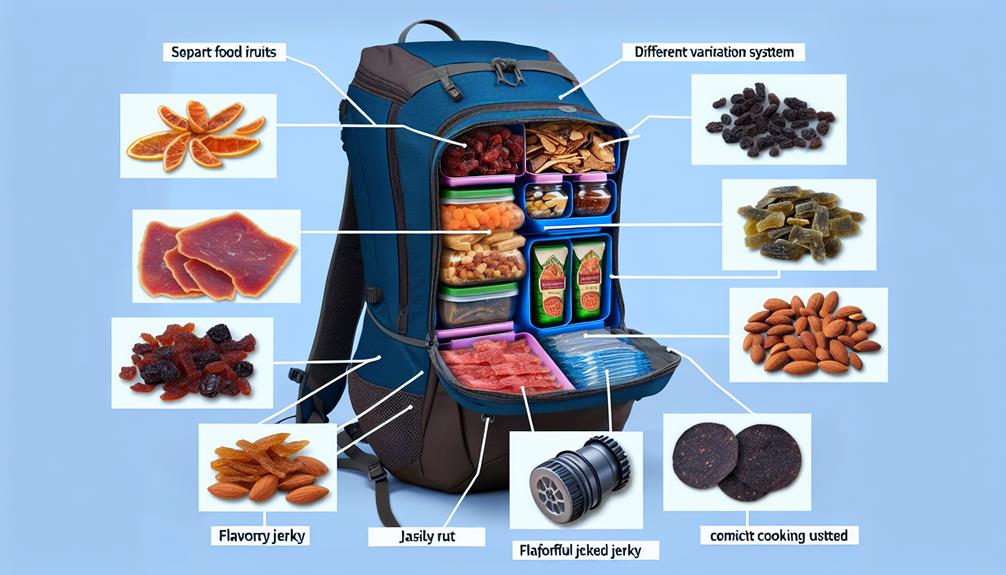
To ensure optimal nutrition during your extended bush trip, carefully consider the weight and composition of the food items you pack, aiming for a daily intake of about 700 grams to 1kg per person. When meal portioning, include small quantities of highly flavored ingredients to add interest to meals, as a balanced hiking diet includes more fat and sugar than a normal diet. Pack breakfast and dinner in separate bags for easy organization, and consider eating directly from your pot to eliminate the need for a bowl. Choose meals that combine taste and nutrition with ease of preparation, and test out food types and amounts at home before the trip. Additionally, consider hydration strategies by packing snacks for longer than expected trips and including simple emergency meals like instant noodles.
Meal Prep and Storage Strategies
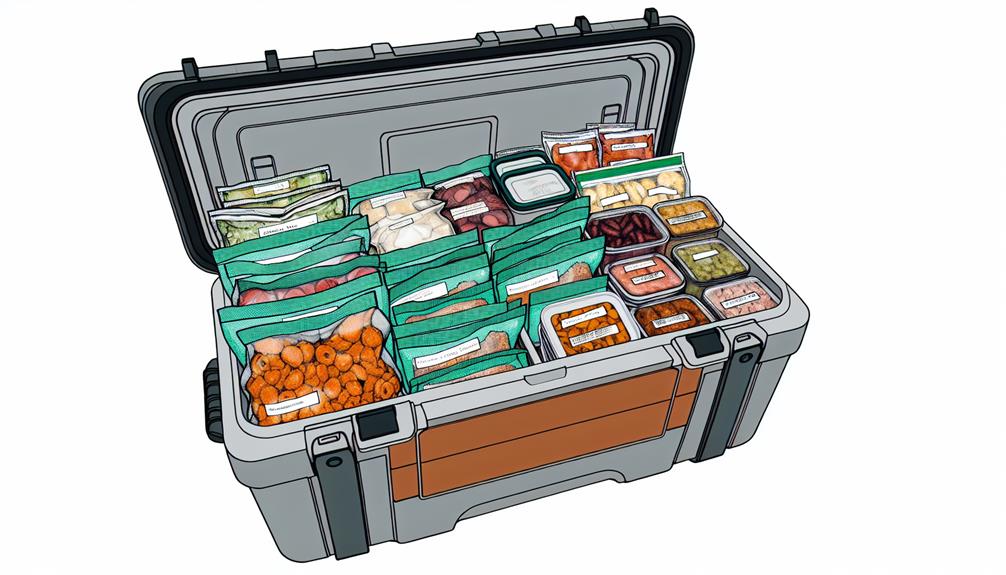
Considering essential nutritional considerations, for extended bush trips, it is crucial to strategize meal prep and storage to ensure a balanced and manageable food supply while minimizing weight and waste. To optimize your mealtime organization, use these packing hacks:
| Packing Hacks | Mealtime Organization | |
|---|---|---|
| Choose lightweight food items | Pack breakfast and dinner separately | |
| Repackage food in reusable snap-lock bags | Organize meals for easy access | |
| Pack 700g – 1kg of food per person per day | Eat directly from cooking pot to reduce dishes |
These strategies will help reduce the weight of your backpack, minimize waste, and simplify meal planning, allowing you to enjoy nutritious and satisfying meals during your extended bush trips.
Cooking Techniques for Bush Trips
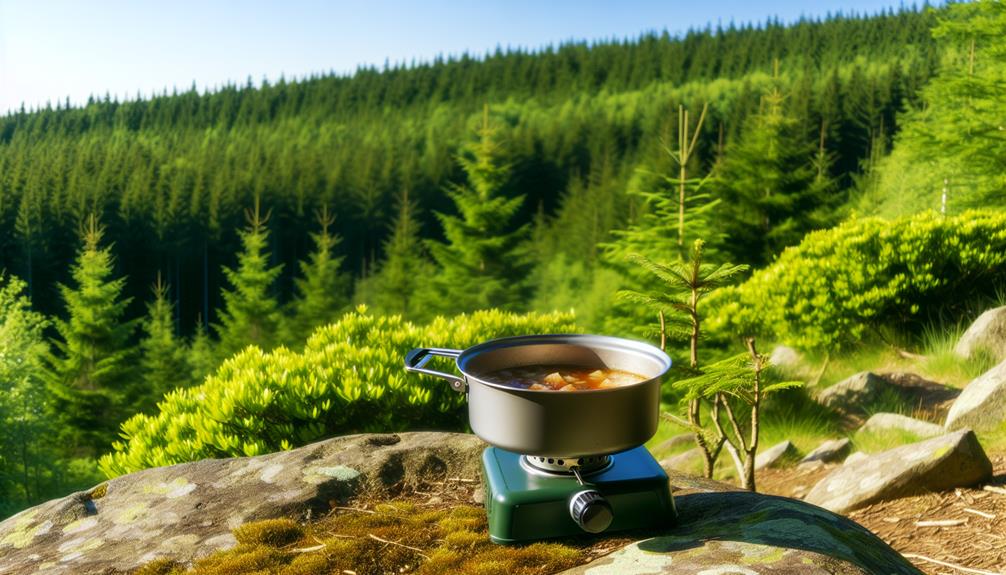
Now it's time to explore cooking techniques that are perfect for bush trips. Campfire cooking methods are a great way to enjoy your meals and the great outdoors. One-pot meal recipes and portable cooking equipment also make cooking in the bush much more convenient.
Campfire Cooking Methods
What are the most effective campfire cooking methods for preparing meals during extended bush trips? When cooking over a campfire, it's essential to use efficient methods that produce delicious meals while conserving resources. Consider the following techniques:
- Open Fire Grilling: Utilize a simple grill grate or skewers to cook meats, vegetables, and even fruits directly over the open flame for a smoky flavor.
- Dutch Oven Recipes: Prepare hearty stews, soups, and even baked goods in a durable and versatile Dutch oven, allowing for a wide variety of meals.
- Foil Packet Cooking: Wrap seasoned ingredients in foil and cook them directly in the coals for easy, mess-free meal preparation.
- Stick Cooking: Skewer foods on sticks and roast them over the fire, perfect for hot dogs, sausages, and marshmallows.
These methods make campfire cooking enjoyable and efficient, providing satisfying meals during your bush trip.
One-Pot Meal Recipes
When embarking on extended bush trips, utilizing one-pot meal recipes can streamline cooking and cleanup while providing nourishing and flavorful meals. For quick and easy camping recipes, consider one-pot meal ideas for outdoor adventures. Look for recipes that require minimal ingredients and preparation to save on weight and space in your pack. Choose versatile ingredients that can be used in multiple one-pot recipes to simplify meal planning. Additionally, incorporating dehydrated or freeze-dried ingredients can reduce weight and prolong shelf life, making them ideal for extended trips. Prioritize nutrient-dense and flavorful ingredients to maintain energy levels and uplift morale during your outdoor excursions. By selecting one-pot meal recipes strategically, you can simplify your cooking process and enjoy delicious, satisfying meals while in the bush.
Portable Cooking Equipment
If you're looking to streamline your cooking process and minimize the equipment needed for meal preparation during extended bush trips, consider incorporating lightweight and compact cooking appliances like the 360 Degrees Furno Stove or MSR Pocket Rocket. These portable cooking equipment options are designed for efficiency and convenience in outdoor settings. To further optimize your cooking setup, consider the following:
- Utilize lightweight utensils to reduce the overall weight of your cooking gear, making it easier to transport.
- Choose cooking appliances with fuel efficiency to make the most out of limited fuel supplies.
- Pack food items in reusable snap lock bags to save space and weight, eliminating excess packaging.
- Consider eating directly from the cooking pot to minimize the need for additional serving dishes, simplifying meal preparation and cleanup.
Menu Diversity and Variety
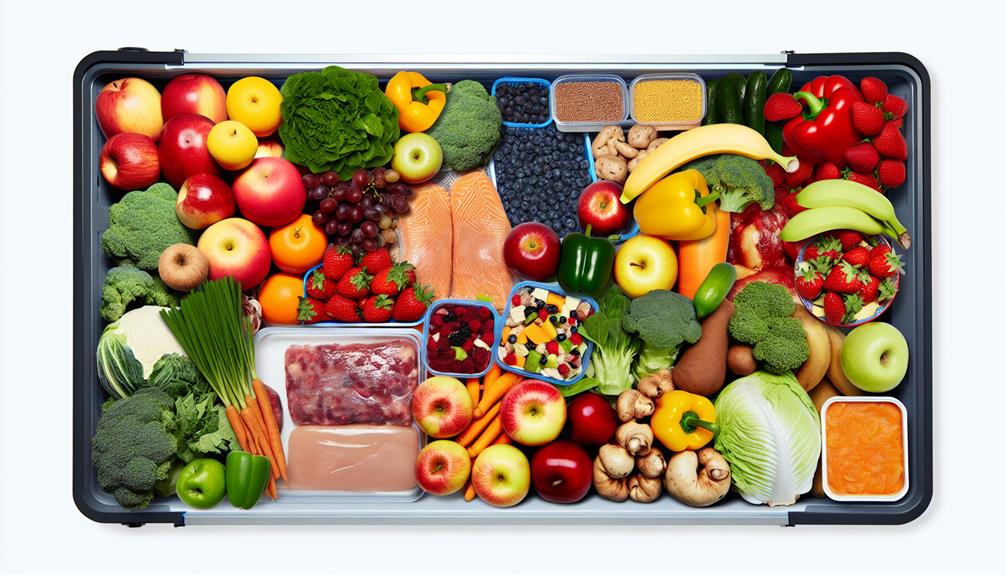
To ensure an exciting and satisfying culinary experience during extended bush trips, it is essential to incorporate a diverse range of food types and flavors into your menu. Creative meal ideas and diverse flavor profiles can elevate the dining experience, making each meal a highlight of your journey. Consider incorporating different cuisines, cooking methods, and ingredients to keep meals interesting and satisfying. Ensure a mix of proteins, carbohydrates, and vegetables to maintain balanced nutrition and energy levels. Explore various breakfast, lunch, and dinner options to cater to varying tastes and preferences, making mealtime an anticipated part of each day. Additionally, plan for dietary diversity by considering food allergies, intolerances, and personal preferences to accommodate all participants, ensuring everyone can enjoy the meals. By prioritizing menu diversity and variety, you can enhance the overall enjoyment and satisfaction of your bush trip.
Top Tips for Extended Bush Trips
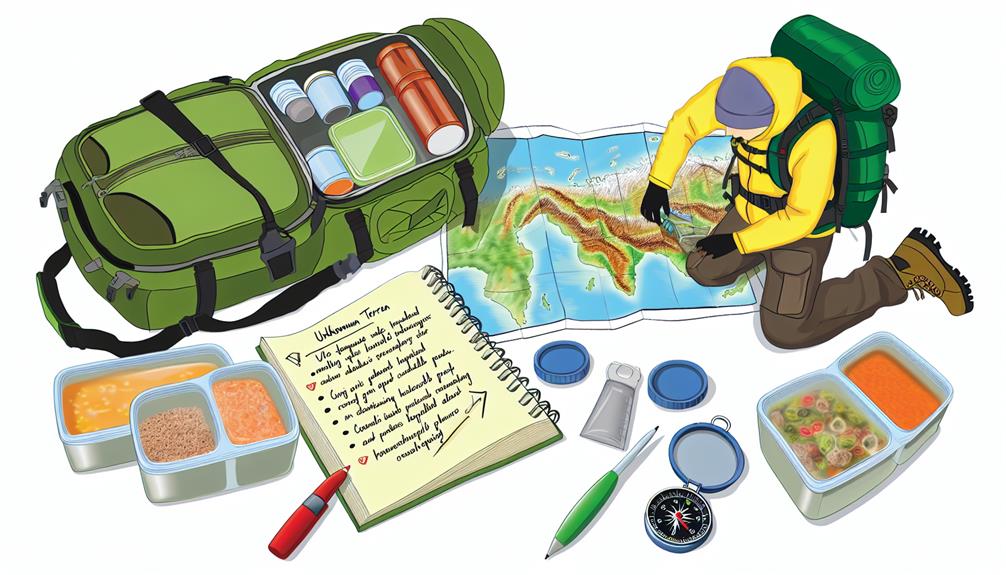
Building on the importance of menu diversity and variety for an exceptional dining experience during extended bush trips, it's essential to consider practical tips that can make your journey more manageable and enjoyable. When planning for extended bush trips, efficient packing strategies and mealtime organization are crucial. Here are some top tips to consider:
- Consider Weight: Choose lightweight, high-calorie foods to minimize the weight of your pack.
- Pack Wisely: Aim to pack about 700 grams to 1kg of food per person per day for longer hiking trips.
- Share and Reduce Weight: Share items with your hiking buddy to reduce the overall weight of the food supplies.
- Organize Meals: Pack breakfast and dinner in separate bags for easy mealtime organization.

